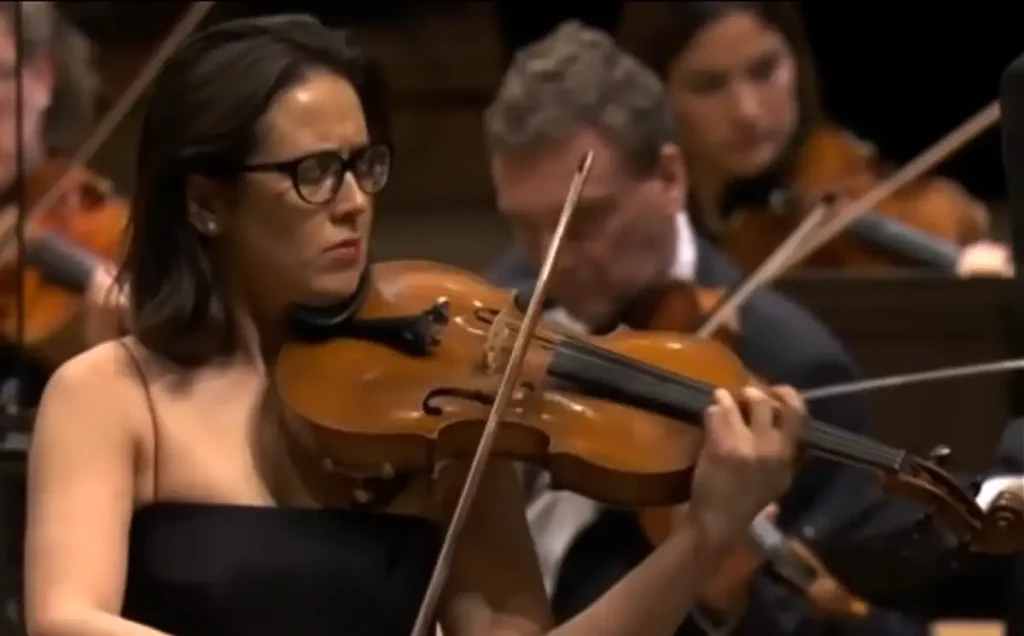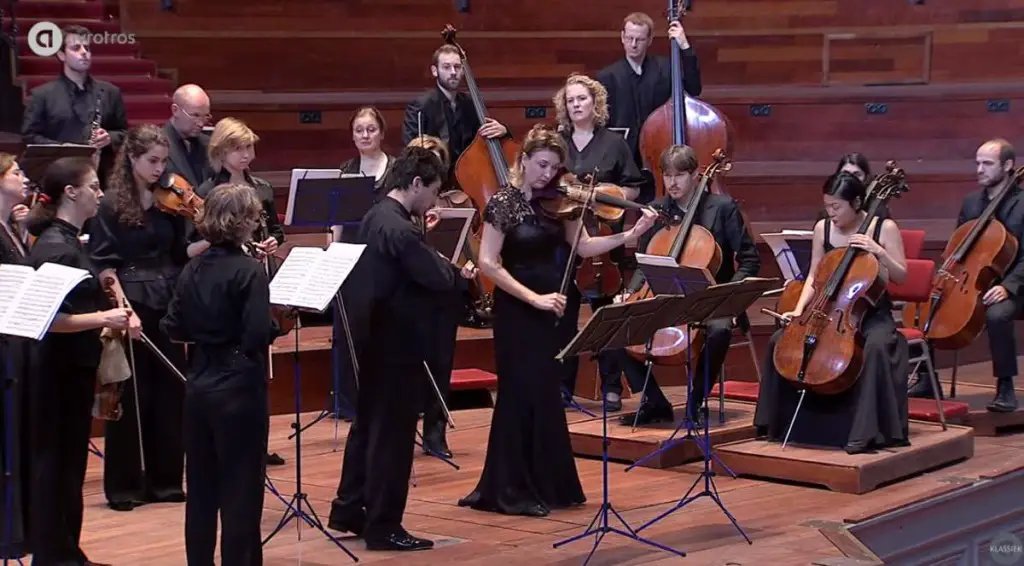Accompanied by the Staatskapelle Berlin, Wolfram Brandl (violin) and Yulia Deyneka (viola) perform Wolfgang Amadeus Mozart’s Sinfonia Concertante for Violin, Viola, and Orchestra in E-flat major, K. 364 (320d). Conductor: Daniel Barenboim.
Mozart’s Sinfonia Concertante for Violin, Viola and Orchestra
At the time of its composition in 1779, Mozart was on a tour of Europe that included Mannheim and Paris. Mozart had been experimenting with the sinfonia concertante genre and this work can be considered his most successful realization in this cross-over genre between symphony and concerto.
Movements:
- Allegro maestoso, common time
- Andante, 3/4, in C minor
- Presto, 2/4
Wolfgang Amadeus Mozart’s Sinfonia Concertante has influenced many arrangers to use these themes. In 1808 an uncredited arrangement of the piece for string sextet Grande Sestetto Concertante was published by Sigmund Anton Steiner. All six parts are divided equally among the six players; it is not presented as soloists with accompaniment.
The Sinfonia Concertante was mentioned in William Styron’s 1979 novel Sophie’s Choice; after a stranger molests Sophie on the subway, she hears the Sinfonia Concertante on the radio, which brings back memories of her childhood in Krakow and snaps her out of her depression.
Variations on the slow second movement were used for the soundtrack to the 1988 Peter Greenaway film Drowning by Numbers by composer Michael Nyman. The original piece is also heard after each of the drownings in the screenplay.
The American composer and bassist Edgar Meyer was so interested in this work that in 1995 he wrote a double concerto for double bass, cello, and orchestra that, while very different in style, closely mirrors the structure of Mozart’s Sinfonia concertante.
The andante movement of this piece was featured in the Turkish director Nuri Bilge Ceylan’s 2002 film Uzak (it was released as Distant in North America, a literal translation of its title).
The first movement of the piece was briefly heard in the 1984 movie “Amadeus”.
Sinfonia concertante is a mixture of the symphony and the concerto genres. It is a concerto in that soloists are on prominent display and a symphony in that the soloists are nonetheless discernibly a part of the total ensemble and not preeminent. It emerged as a musical form during the Classical period of Western music.
In the Baroque period, the differences between a concerto and a sinfonia (also “symphony”) were initially not all that clear. The word sinfonia would, for example, be used as the name for an overture to stage work.
Antonio Vivaldi wrote “concertos” which did not highlight individual soloists and which were stylistically more or less indistinguishable from his “sinfonias.” The Baroque genre that comes closest to the Classical sinfonia concertante is the concerto grosso; among the most famous of these are those by Arcangelo Corelli.
By the Classical period (roughly 1750-1800), both the symphony and the concerto had acquired more definite meanings, and the concerto grosso had disappeared altogether. This led in the last decades of the 18th century to attempts to combine the two genres, such as those by composers of the Mannheim school.
Johann Christian Bach (the so-called “London Bach” and youngest son of Johann Sebastian) was publishing symphonies concertantes in Paris from the early 1770s on. Mozart, acquainted with the Mannheim school from 1777 and probably aware of J.C. Bach’s publications, put considerable effort into attempts to produce convincing sinfonie concertanti. His most successful are the following:
- Sinfonia Concertante for Violin, Viola and Orchestra K. 364 (the only one Mozart is actually considered to have finished that exists in an authentic copy).
- Sinfonia Concertante for Oboe, Clarinet, Horn, Bassoon, and Orchestra K. 297b (known from an arrangement, possibly inauthentic).
Joseph Haydn also wrote a Sinfonia Concertante for Violin, Cello, Oboe, and Bassoon during his visit to London, in a friendly challenge to his former student Ignaz Pleyel, who also stayed in London at the time, and whose works in the genre were highly popular. Haydn also wrote symphonies with long soloist parts, especially early in his career, such as the “Time of Day” symphonies 6-8. These are, however, rightfully considered symphonies rather than sinfonie concertanti.
Yulia Deyneka
Julia Deyneka was born in Russia in 1982. Aged 12, she wins a place at the Central Music School as a violinist in her hometown of Moscow. Her teacher: Maria Sitkovskaya, a former student of viola legend Vadim Borisovsky.
Soon after, she holds a viola in her hands for the first time. Immediately she is fascinated by the proximity of the sound to the human voice and the versatile role of the viola in chamber music.

At the Tchaikovsky Conservatory, she studies with Alexander Bobrovsky. During a masterclass in Germany, she makes the acquaintance of violist Felix Schwartz. He offers to teach her at Rostock University of Music and Drama. Yulia agrees on the spot, graduating successfully from both institutions.
In 2003 she passed the audition for the Berlin Staatskapelle Orchestra Academy and fell in love with Germany’s biggest city. Not long after her 22nd birthday, she is already playing principal viola in the Staatskapelle orchestra in Berlin, by the side of her former mentor Felix Schwartz.
But Yulia wants more. She wants to keep learning. So she goes on to study with Wilfried Strehle at the UdK Berlin, where she gained her “Konzertexamen” in 2014. For some time she has been teaching viola herself, first at Rostock University of Music and Drama, then at the music academy of the Barenboim-Said Foundation in Seville.
She plays in Daniel Barenboim’s West-Eastern Divan Orchestra and is the mentor of the viola section for 10 years.
Her collaboration with pianist and conductor Barenboim intensifies, who now describes her as “one of his favorite chamber music partners”. In 2016 Yulia was awarded a teaching post at the Barenboim-Said Academy in Berlin, graduating to a professorship in the winter semester of 2019. She continues to mentor the orchestra academy of the Berlin Staatskapelle.
“Yulia Deyneka is not just one of the finest violists I know – she is also one of my favourite chamber music partners”.
Daniel Barenboim
Yulia Deyneka’s musical path has led to musical collaborations with numerous renowned artists including Martha Argerich, Yo-Yo Ma, Maurizio Pollini, and Radu Lupu. She has received musical inspiration under the baton of game-changing conductors such as Pierre Boulez, Zubin Metha, Simon Rattle, Andris Nelsons, and Francois-Xavier Roth.
As a soloist, she has played Strauss’s “Don Quixote” with Misha Maisky under the direction of Massimo Zanetti. Under Andris Nelsons she has performed Alfred Schnittke’s viola concerto, and in 2015 she took the solo part in Mozart’s “Sinfonia Concertante” alongside Wolfram Brandl in both the Carnegie Hall and the Paris Philharmonie. On the podium: Daniel Barenboim.
Recordings featuring Yulia have been released on CD and album streams. She has recorded Boulez’s “Messagesquisse” in the arrangement for viola with François-Xavier Roth and the Boulez Ensemble for the Peral label. “Drei Charakterstücke” by David R. Coleman, written especially for Yulia, was released by NAXOS, and Mozart’s two piano quartets by Deutsche Grammophon.
In 2019, she collaborated with soprano Magdalena Kožená and Sir Simon Rattle (in the role of pianist) on the album “Soirée” (PENTATONE).
Wolfram Brandl

Wolfram Brandl was born in Würzburg in 1975. At the age of eight, he received his first violin lessons from his father. At school, he had lessons with Prof. Max Speermann in Würzburg.
He won several 1st prizes at “Jugend musiziert” at the federal level and was concertmaster of the National Youth Orchestra. With the support of the Jürgen Ponto Foundation, he went to Berlin after graduating from high school in 1994 to study at the University of the Arts with Prof. Uwe-Martin Haiberg.
Before becoming 1st concertmaster of the Staatskapelle Berlin under Daniel Barenboim in 2011, he was the first violinist with the Berliner Philharmoniker for ten years, where he received decisive artistic impulses.
In addition to his work as concertmaster, Wolfram Brandl is 1st violinist of the Scharoun Ensemble Berlin, which was founded in 1983 by members of the Berliner Philharmoniker.
With this chamber music formation, he has recently made guest appearances at Carnegie Hall in New York, Wigmore Hall in London, the Konzerthaus in Vienna, the Concertgebouw Amsterdam, and La Scala in Milan. In addition to the classical chamber music repertoire, the ensemble is also increasingly dedicated to contemporary music.
Many artistic impulses resulted from encounters with Pierre Boulez, Christoph Penderecki, Heinz Holliger, Thomas Adés, Matthias Pintscher, Brett Dean, and Jörg Widmann. Numerous recordings document his work and have been awarded prizes such as the Echo or most recently the International Classical Music Award 2012.
Wolfram Brandl lives with his family of four children in Berlin.
Sources
- Sinfonia Concertante for Violin, Viola and Orchestra (Mozart) on Wikipedia
- Sinfonia concertante on Wikipedia
- Yulia Deyneka’s official website
![Mozart: Sinfonia Concertante [Staatskapelle Berlin, Daniel Barenboim]](https://cdn-0.andantemoderato.com/wp-content/uploads/2015/03/Mozart-Sinfonia-Concertante-Staatskapelle-Berlin-Barenboim.jpg)

